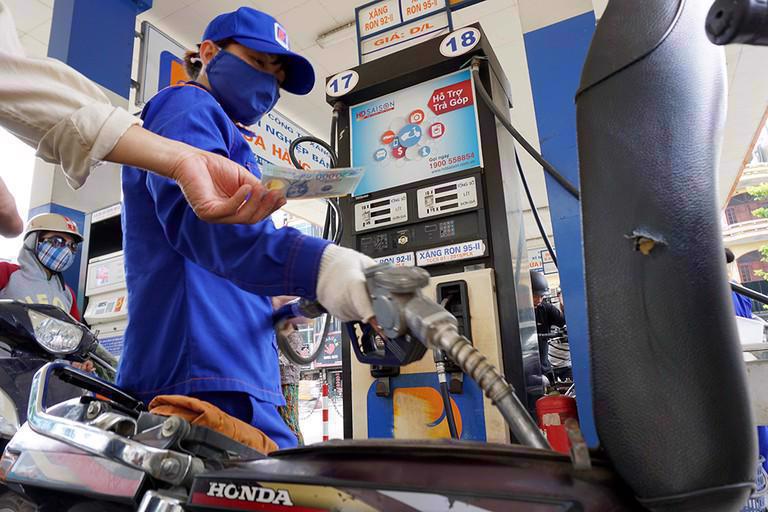Vietnam’s fuel price projected to hit VND23,000 per liter in Q3
This represents an increase of nearly VND2,000 per liter for RON95 compared to the current price, bringing it close to the price threshold observed in November 2022.
The price of RON95 gasoline, which currently accounts for 70% of the total amount of gasoline products consumed in the domestic market, is expected to reach up to VND23,000 (US$0.97) per liter in the third quarter.
| A petrol station in Hanoi. Photo: Pham Hung/The Hanoi Times |
The Ministry of Industry and Trade (MoIT) released the forecast in its latest report, which assumes that the global price will hit $98 per barrel.
Based on the ministry's analysis, the current domestic gasoline prices are significantly lower compared to the first half of 2022. Specifically, RON 95 gasoline is priced at VND21,420 ($0.91) per liter, representing a 35% decrease. Diesel is 39% cheaper, followed by kerosene at 37% cheaper and mazut at 29% lower.
However, the MoIT expects domestic fuel prices to rise again in the third quarter due to an increase in global prices. According to the analysis and forecast of global consulting firm Wood Mackenzie, the average global crude oil price is expected to be between $87-92 per barrel, resulting in finished product prices of about $90-98 per barrel for gasoline and diesel.
Although these levels reflect a decrease of nearly 13-23% compared to the same period in 2022, they are expected to increase by about 1-2% compared to the first half of 2023.
Under the scenario of an average world oil product price of $90 per barrel, the MoIT expects the prices of biofuel E5-RON92 gasoline to be VND21,325 ($0.9), RON95 gasoline to be VND21,597 ($0.91), and diesel oil to be VND18,115 ($0.77).
If the world finished product price reaches $98 per barrel, the price of diesel oil would be VND19,415 ($0.82) per liter, E5-RON92 would be VND22,657 ($0.96) per liter, and RON95 would be VND23,049 ($0.98) per liter. This represents an increase of nearly VND2,000 per liter for RON95 compared to the current price, bringing it close to the price threshold observed in November 2022.
To mitigate significant fluctuations in domestic fuel prices compared to global prices, the MoIT, in cooperation with the Ministry of Finance (MoF), plans to use the price stabilization fund tool flexibly. This approach aims to control inflation, support economic recovery, and ensure that the Price Stabilization Fund has sufficient room to operate during periods of market uncertainty and high price trends.
According to the General Department of Vietnam Customs, the country imported nearly 4.2 million tons of oil in the year's first five months. Of these imports, diesel oil accounted for about 53% (2.2 million tons), gasoline for 22%, and fuel oil for the rest. On average, Vietnam imports more than 0.8 million tons of gasoline and oil every month.
The two domestic oil refineries, Nghi Son and Binh Son, have a combined monthly production capacity of about 1.1 million tons of petroleum products. At the end of May, the inventory of these focal points was about 1.6 million cubic meters.
Starting on August 25, the Nghi Son refinery, which accounts for more than 35% of the domestic fuel supply, will enter a maintenance period expected to last until late September or early October. To prevent a recurrence of supply disruptions experienced during previous maintenance periods, Minister of Industry and Trade Nguyen Hong Dien announced on July 4 that key gasoline retailers would be urged to effectively implement plans to allocate the minimum required total petroleum resources.
The MoIT has assigned the Vietnam Oil and Gas Group (PVN) to supervise oil refineries and prepare comprehensive plans to ensure their stable operation.
PVN is also responsible for developing scenarios, including technical, human resources, materials, and raw materials, to enable refineries to operate at full capacity and possibly exceed their regular output.
In addition, petrol retailers have been instructed to calculate the expected production shortfall during the Nghi Son refinery maintenance period. These calculations will help prepare a supply plan for the distribution system and the market.
To ensure that enterprises have sufficient resources, the MoIT has asked the MoF to promptly adjust the cost of gasoline and oil trading in the base price formula. Banks are encouraged to provide favorable conditions such as credit lines, preferential interest rates, and foreign exchange support to oil companies to enable them to acquire the necessary funds to import and purchase fuel.











